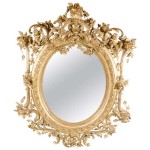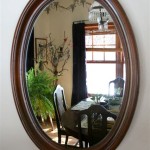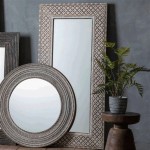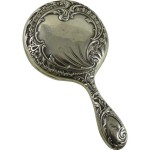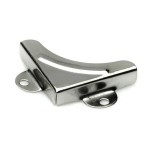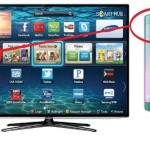What Is a Non-Beveled Mirror?
A non-beveled mirror is a mirror without a beveled edge. A bevel is a sloped edge, often at a 45-degree angle, created by grinding and polishing the perimeter of a mirror. While beveled mirrors offer a decorative touch, non-beveled mirrors provide a clean, modern, and often more affordable alternative.
The absence of a bevel results in a flat, uninterrupted reflective surface extending to the very edge of the mirror. This characteristic makes non-beveled mirrors suitable for various applications where a seamless look is desired, such as mirrored walls, furniture insets, and certain types of framing.
The manufacturing process for non-beveled mirrors is generally simpler than that of beveled mirrors. After the initial mirror formation, which involves coating glass with a reflective backing like silver or aluminum, the edges are typically polished or ground smooth. However, unlike beveled mirrors, the edges are not angled. This simplified production often translates to a lower cost compared to beveled counterparts.
Non-beveled mirrors exhibit specific characteristics influencing their suitability for different applications. The absence of a bevel eliminates the light refraction inherent in angled edges, leading to a truer reflection. This can be beneficial in situations where accurate reflections are paramount.
The sharp, 90-degree edges of a non-beveled mirror can present a safety concern, particularly for larger mirrors. While modern manufacturing processes often include edge smoothing or polishing to minimize sharpness, caution is still advised during handling and installation. Protective backing, like safety film, can further mitigate risks associated with potential breakage.
Choosing between a beveled and non-beveled mirror depends largely on the intended application and aesthetic preferences. Beveled mirrors add a decorative element, creating a framed appearance and adding depth. They are often used as statement pieces or in traditional settings. Non-beveled mirrors, conversely, offer a sleek, minimalist aesthetic suitable for contemporary designs. Their seamless surface makes them ideal for creating continuous reflective surfaces or for applications where the mirror's edges will be concealed by a frame or other material.
Several practical considerations can influence the choice between beveled and non-beveled options. Cost is frequently a factor, with non-beveled mirrors generally offering a more budget-friendly solution. Size and weight also play a role. Large non-beveled mirrors can be heavy and require robust mounting systems, while their sharp edges necessitate careful handling. The overall design aesthetic of the space should also be considered. A beveled mirror might clash with a minimalist interior, while a non-beveled mirror might appear too plain in a more ornate setting.
Non-beveled mirrors are frequently used in a variety of applications across residential, commercial, and specialized settings. In homes, they are commonly found in bathrooms, bedrooms, and hallways. Their clean lines complement modern bathroom vanities and create the illusion of larger spaces. In commercial settings, non-beveled mirrors are utilized in gyms, dance studios, and retail spaces where large, uninterrupted reflections are desirable. Specialized applications include scientific instruments, optical devices, and solar installations where precise reflection is critical.
When installing non-beveled mirrors, certain precautions and best practices should be followed to ensure safety and longevity. Proper mounting hardware and techniques are essential, especially for larger, heavier mirrors. Using adhesives designed specifically for mirrors ensures a secure bond. Protective gloves and eyewear should be worn during installation to prevent injury from sharp edges. Careful measurement and planning are crucial to achieve a precise fit and avoid unnecessary cutting or modification of the mirror.
Maintaining non-beveled mirrors is relatively straightforward. Regular cleaning with a glass cleaner and a soft cloth helps maintain their reflectivity and removes smudges and fingerprints. Avoid using abrasive cleaners or materials that can scratch the mirror surface. For stubborn stains or residues, a solution of diluted vinegar or rubbing alcohol can be effective. Promptly addressing any chips or cracks in the edges prevents further damage and maintains the mirror's structural integrity.
The versatility of non-beveled mirrors makes them a suitable choice for a wide range of design styles and practical applications. Their clean, contemporary aesthetic blends seamlessly with modern interiors, while their uninterrupted reflective surface offers functional advantages in various settings. By understanding the characteristics and considerations associated with non-beveled mirrors, one can make informed decisions when selecting and installing mirrors for various purposes.

42 X 31 Non Beveled Wood Bathroom Wall Mirror Brushed Sterling Silver Amanti Art Target

Amanti Art Non Beveled Corded Broe 18 In W X 52 H On The Door Mirror Full Length A38867155754 Home Depot

24 X 30 Non Beveled Parlor White Bathroom Wall Mirror Amanti Art Target

23 X 29 Non Beveled Hardwood Whitewash Wood Wall Mirror Amanti Art Target

Amanti Art Non Beveled Lined Broe 29 12 In W X 65 H Decorative Floor Leaner Mirror A38867155747 The Home Depot

Amanti Art Narrow Non Beveled Rectangle Framed Bathroom Wall Mirror 27 12 X 21 Pinstripe Plank Gray Office Depot

Amanti Art Non Beveled Rectangle Wood Framed Bathroom Wall Mirror 27 X 21 Woodridge Rustic Gray Office Depot

Amanti Art Bark Rustic Non Beveled Bathroom Wall Mirror Target

Avm Enterprises Inc Calisto Non Beveled Full Length Mirror 20 X60

Amanti Art Non Beveled Salon Silver Narrow 26 5 In W X 62 H Decorative Floor Leaner Mirror A38867155749 The Home Depot
